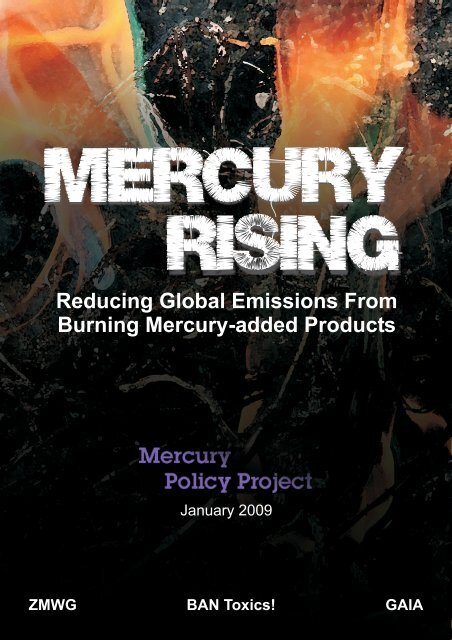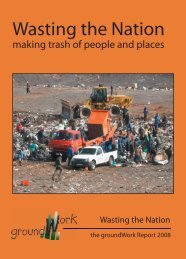MERCURY RISING – Executive summary - GAIA
MERCURY RISING – Executive summary - GAIA
MERCURY RISING – Executive summary - GAIA
You also want an ePaper? Increase the reach of your titles
YUMPU automatically turns print PDFs into web optimized ePapers that Google loves.
<strong>MERCURY</strong> <strong>RISING</strong> <strong>–</strong> <strong>Executive</strong> <strong>summary</strong>A report of the Mercury Policy ProjectPage iiReport findingsIn this report, the main burning processes investigated were medical waste incineration,municipal and hazardous waste incineration, municipal wastewater sludge incineration,and landfill fires and open burning. For these four categories, the global mercuryreleases to the air from the burning of wastes containing mercury-added products 1 areestimated as follows.Global mercury emissions (tonnes) to air from burning mercury-added products (2005)AtmosphericKey waste stream burning processesmercury emissions(tonnes)Medical wasteincinerationIncineration of mercury-added products inmunicipal and hazardous wasteIncineration of municipal wastewater sludgefrom productsLandfill fires and open burning of mercuryaddedproducts in domestic waste10-2545-702-845-100Total ~100-200The distribution of emissions among these burning processes is presented graphically inthe following figure.Global mercury emissions (tonnes) to air from burning mercury-added products (2005)Lower end of rangeUpper end of rangeLandfillfires &openburning,45Munic.wastewatersludgeincin.,2Medicalwasteincin.,10Munic. &haz.wasteincin.,45Landfillfires &openburning,100Munic.wastewatersludgeincin.,8Medicalwasteincin.,25Munic. &haz. wasteincin.,701 A “mercury-added product” is defined as any product (e.g. batteries, thermometers, dental amalgam) to whichmercury is intentionally added in order to perform the function for which the product is intended. For example, coal isnot a mercury-added product since the mercury occurs as a trace contaminant and is not intentionally added. Causticsoda is not a mercury-added product since the mercury occurs as incidental contamination in plants using the mercurycell chlor-alkali process.ZMWG BAN Toxics! <strong>GAIA</strong>
<strong>MERCURY</strong> <strong>RISING</strong> <strong>–</strong> <strong>Executive</strong> <strong>summary</strong>A report of the Mercury Policy ProjectPage vThere are other product waste related sources of air emissions not investigated in thisanalysis, and not included in the tables and figures above, but estimated by otherresearchers, include cremation (20-30 tonnes Hg), industrial incineration of productmanufacturing wastes and sludges (10-25 t Hg), non-combustion landfill emissions (10-45 t Hg), emissions during waste handling (3-8 t Hg), emissions from the wastewatertreatment process (4-8 t Hg) and emissions from products that go through metal scrapprocessing (5-10 t Hg). Together these additional sources come to 50-125 t Hg.Finally, product-related sources not linked to waste disposal, such as productmanufacturing emissions, product breakage during use, etc., have been estimated byother researchers at 15-40 t Hg. When added to all of the above sources, globalproduct-related mercury emissions are in the range of 165-365 t, with a best estimatearound 250 t Hg, or about 10% of all anthropogenic mercury emissions.The combined estimates of global anthropogenic emissions of the three recent researchreports cited above are shown in the following figure, relative to total product-relatedemissions. It should be noted that product-related emissions are of the same generalmagnitude as major industrial process emissions and metal refining emissions, both ofwhich are already subject to particular scrutiny.Relative contribution of main anthropogenic sources of mercury emissions to air (~2005)Main anthropogenic contributors to globalatmospheric mercury emissionsArtisanal goldmining14%Other metalrefining &production12%Fossil fuelcombustion51%Product relatedemissions10%Cement, chloralkali& othernon-productmfg.9%Other wastehandling &disposal, landfillemissions,emissionsduring productuse, etc.4%ZMWG BAN Toxics! <strong>GAIA</strong>
















